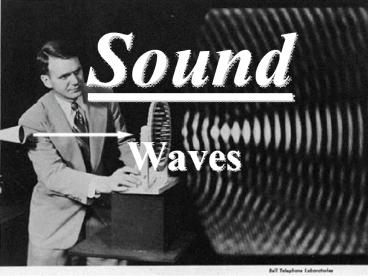Sound - PowerPoint PPT Presentation
Title:
Sound
Description:
sound waves decibel measures the loudness of sound relates to the amplitude of the wave every increase of 20db has 10x greater amplitude 150db jet taking off 115db ... – PowerPoint PPT presentation
Number of Views:105
Avg rating:3.0/5.0
Title: Sound
1
Sound
- Waves
2
Sound Wave Properties
3
Sound Waves are Longitudinal Waves
The air molecules shown below are either
compressed together, or spread apart. This
creates alternating high and low pressure.
4
Frequency
- The frequency of a sound wave (or any wave) is
the number of complete vibrations per second. - The frequency of sound determines its pitch.
- Human Hearing ranges from
- . 20Hz to 20KHz
5
The higher the frequency, the higher the pitch
6
Wavelength
- Wavelength is the distance between two high
pressures, or two low pressures. This property
is dependent on the velocity of the sound and
its frequency.
7
AmplitudeThe Amplitude of a Sound Wave
Determines its loudness or softness
8
Velocity of Sound
9
The velocity of sound depends on
- The medium it travels through
- In air at room temperature sound travels at
343m/s (766 mph) - v 331 m/s (0.6)T
- v velocity of sound in air
- T temperature of air in oC
10
Relationship between velocity, frequency, and
wavelength
- V ?f
- V velocity of sound
- ? wavelength of sound
- f frequency of sound
11
- Sound travels faster in liquids than in air
- Sound travels faster in solids than in liquids
- Sound does not travel through a vacuum
- there is no air in a vacuum so sound has no
medium to travel through
12
Echoes REFLECTION
13
Echoes are the result of the reflection of sound
Sound waves leave a source, travel a distance,
and bounce back to the origin.
14
Things that use echoes...
- Bats
- Dolphins/ Whales
- Submarines
- Ultra sound
- Sonar
15
REFRACTION OF WAVES
16
(No Transcript)
17
Refraction of Sound
- Refraction is the bending of waves when they
enter a medium where their speed is different
18
(No Transcript)
19
DIFFRACTION
- THE BENDING OF WAVES THROUGH A SMALL OPENING
20
BENDING OF A WAVE
21
Beats
22
A beat occurs when sound waves of two different
(but very much alike) frequencies are played next
to each other. The result is constructive and
destructive interference at regular intervals.
23
Sound waves move out like this
24
But when they move, the front of the wave gets
bunched up (smaller wavelength) and the back of
the wave starts to expand (larger wavelength)
25
Observer C hears a high pitch (high frequency)
Observer B hears the correct pitch (no change in
frequency)Observer A hears a low pitch (lower
frequency)
26
Police use the Doppler Shift when measuring your
speed with radar
- A frequency is sent out of the radar gun
- The sound wave hits the speeding car
- The frequency is changed by the car moving away
from the radar and bouncing back - The amount the frequency changes determines how
fast you are going - The faster you are going, the more the frequency
is changed.
27
When the source goes faster, the wave fronts in
the front of the source start to bunch up closer
and closer together, until...
www.youtube.com/watch?vKg9F5pN5tlI
28
The object actually starts to go faster than the
speed of sound. A sonic boom is then created.
29
Resonance
http//videos.howstuffworks.com/tlc/29833-understa
nding-tacoma-narrows-bridge-video.htm
30
- Resonance happens with closed pipe resonators and
open pipe resonators - Resonance occurs when there is a standing wave in
the tube - Closed pipe resonators
- open end of tube is anti-node
- closed end of tube is node
- Open pipe resonators
- both ends are open
- both ends are anti-nodes
31
Closed pipe resonator
32
Open pipe resonator
http//www.youtube.com/watch?v-gr7KmTOrx0
33
SOUND INTENSITY
- THE LOUDNESS OF SOUND
34
DECIBEL
- MEASURES THE LOUDNESS OF SOUND
- RELATES TO THE AMPLITUDE OF THE WAVE
- EVERY INCREASE OF 20dB HAS 10x GREATER AMPLITUDE
35
150dB JET TAKING OFF 115dB CHAIN
SAW 100dB POWER MOWER 80dB NOISY
RESTAURANT 75dB VACUUM CLEANER 50dB AVERAGE
HOME 25dB PURRING CAT 20dB RUSTLING LEAVES
15dB WHISPER 0dB FAINTEST THAT CAN BE
HEARD
36
A SOUND 10 TIMES AS INTENSE IS PERCEIVED AS BEING
ONLY TWICE AS LOUD
37
NOISE POLLUTION
- Prolonged exposure to noise greater than 85-90
dBA (decibels measured on the A-scale) may cause
hearing loss - Brief exposures to noise sources of 100-130
dBA can cause hearing loss - A single exposure to a level of 140 dBA or
higher can cause hearing loss































